40 Best Spring Flowers to Beautify Your Backyard, According to Gardening Experts

Colorful spring flowers
Spring has sprung! As winter has started fading away and the days have grown longer, nature is beginning to awaken for spring. One of the most exciting parts of the early spring season is the leaves turning green and flowers starting to bloom. And if you're looking to liven up your backyard, there's no better way than to plant or add spring flowers.
Not only are these blooms a nice pop of color (purple, red, yellow, pink and more!) to the sometimes rainy and muddy season, but they are a great nutrient resource for early emerging critters—like bees and butterflies—as well.
Parade spoke with four flower and plant experts to figure out which spring flowers are the best for your yard: Stephanie Walker is a certified master gardener, author, the blogger behind The Potter’s Bench, Annette Thurmon is an author and founder of Azure Farm, Kara Jamison is a cut flower garden grower, educator and the founder of Blooming Joy Flower Company, and Gina Mellard, who runs Gina's Flower Garden on Instagram.
It doesn't matter if you're an avid gardener with a green thumb, a total newbie or simply a nature enthusiast eager to absorb the beauty of the season. Planting these gorgeous annuals and perennials around your yard is sure to inspire and uplift your home atmosphere.
"Planting spring flowers not only creates visually stunning landscapes, but also serves various practical purposes," Thurmon notes. "For example, they attract essential pollinators, such as bees and butterflies, promoting biodiversity and supporting ecosystem health."
Mellard adds that spring flowers "are some of the easiest flowers to grow and you can adapt depending on your budget. It’s so exciting designing your spring borders, planting containers, thinking of color schemes and seeing it all come together."
Keep reading for these experts' tips, tricks and favorites (with names and images) among this list of 40 spring flowers.
Related: Cloudy Day? No Problem! 19 Best Vegetables and Plants To Grow in the Shade
What Are the Most Common Flowers in Spring?
Jamison and Walker tell Parade that the most common flowers in spring are usually tulips, daffodils, hyacinths and peonies.
Walker adds that ranunculus, anemones and crocuses are also gaining popularity.
Related: 35 Magical Fairy Garden Ideas To Enchant Your Backyard
40 Best Spring Flowers
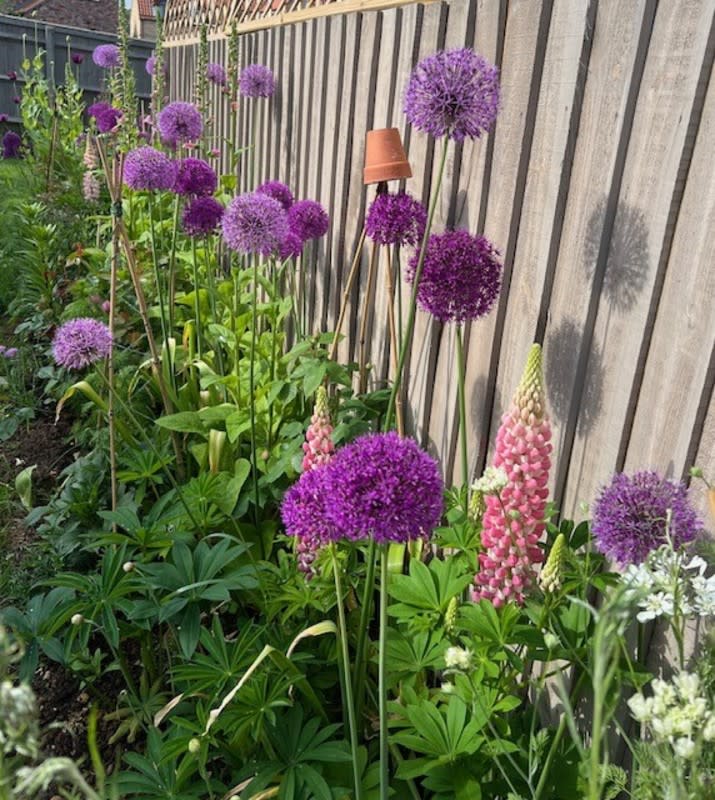
Ginna Mellard - Gina's Flower Garden on Instagram
1. Allium
Alliums are in the same relative group as garlic, chives and leeks. They are adorable flowers that can grow between three to five feet tall.
Mellard says planting allium was, "One of the best things I did as a beginner gardener [because] they are quick and easy to plant, the bees love them, [and] they provide beautiful structure long after they flower."
Pros: They come in a lot of different varieties from giant to small, so you can add different varieties and heights to the border, Mellard explains.
Cons: According to Mellard, you may have to dig them up to divide them after a year or two as they can come back in clumps.
2. Alyssum
One of the most fragrant spring flowers is the alyssum, making it a magnet for bees and hummingbirds. Alyssum come in a large variety of colors and are extremely popular for containers, hanging baskets and garden beds.
Pros: They are tough and produce plentiful blooms.
Cons: Needs full sun and soil that drains well.
Related: Roses Are Red, Violets Are Blue—Here's an Essential Guide to the Meanings of Flowers for You
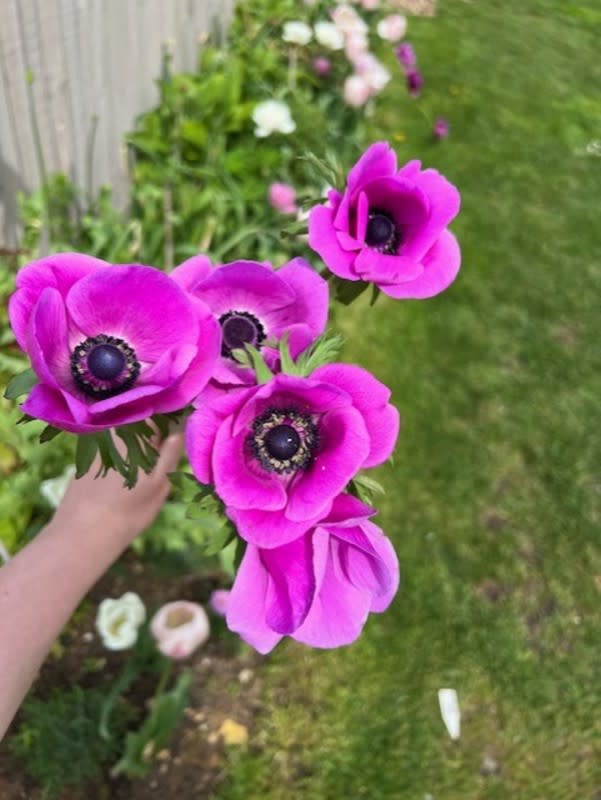
Gina Mellard - Gina's Flower Garden on Instagram
3. Anemones (Windflowers)
Anemones are an early spring blooming perennial flower that are simple, yet elegant. The petals may be single or double-layered, depending on the variety. They come in an array of colors such as pinks, purples, whites and reds. Anemones grows tall and have an airy quality.
Walker tells Parade, "Just under the bloom is a fringy green collar that is tucked up close to the flower. Once the flower blooms, it opens each morning and closes at night. As it does this, the stem lengthens and the collar seems to move down the stem, thus letting you know that the farther the collar is from the bloom, the older the bloom."
Mellard adds that anemones, or windflowers, "are stunningly beautiful, with large blooms on long, upright strong stems which are perfect for cut flowers (they last ages in a vase)," explaining that they actually remind her of "parsley."
Pros: They can naturalize, which is great, explains Mellard, and they look lovely in containers next to tulips.
Cons: Some varieties are half-hardy, so Mellard says they may need a little frost protection in some areas. The flowers also don't fully open if there's not a lot of sun.
4. Azalea
Azaleas are stunning flowering shrubs prized for their vibrant blooms and lush foliage, adding a burst of color to gardens in spring. They are perfect when used as hedging or throughout your landscaping. Thurmon recommends planting them in well-draining, acidic soil in partial shade, ensuring they receive adequate moisture without waterlogging. Pruning after flowering will help maintain their shape and encourage vigorous growth.
This flowering bush comes in so many breathtaking colors: white, red, purple and yellow, with every other color imaginable in between.
Pros: Although pruning is recommended, it's not required for this particular plant.
Cons: Slow growing, some species can take up to 10 years to fully mature. They are also toxic to pets and humans.
5. Bluebells
Bring the woodland right into your backyard with this adorable little bell-shaped beauty. Bright blues spring up from vibrant greenery, usually around mid-spring. They thrive in moist soil and partial shade.
Pros: You can easily prevent self-seeding by deadheading (picking of the dead flower "head").
Cons: After blossoming, the leaves of bluebells will slowly die back, leaving an empty space in your garden.
6. Bloodroot
Another early riser in springtime, bloodroot flaunts large white flowers with yellow, delicate centers. The reason for its name, interestingly enough, is because they have a "bloody" looking sap flowing through its roots.
Pros: Flowers only last about two days, opening in the morning and closing nightly. Their foliage will stay green until about mid-summer, however.
Cons: Too much of a good thing! Bloodroots can form colonies and large root systems, be careful where you plant them to avoid them taking over your other flowers. Also, the sap is caustic to the skin and toxic if swallowed.
Related: What Is Your Birth Flower? Find Out the Meaning Behind the Blooms for Each Month
7. Columbine
This very unique and popular flower grows well in backyards and is a nice addition to rock gardens. They don't mind soaking up sun or living in dry conditions. When flowers are done, the pods will dry out, leaving tons of seeds for you to gather and respawn.
Pros: Once the first batch of flowers are done, trim the stems back to the first healthy base leaves, and you will be blessed with another round of flowers.
Cons: They are prolific and will reseed themselves. When planting them in your backyard, you will have to take care that they don't overpopulate.
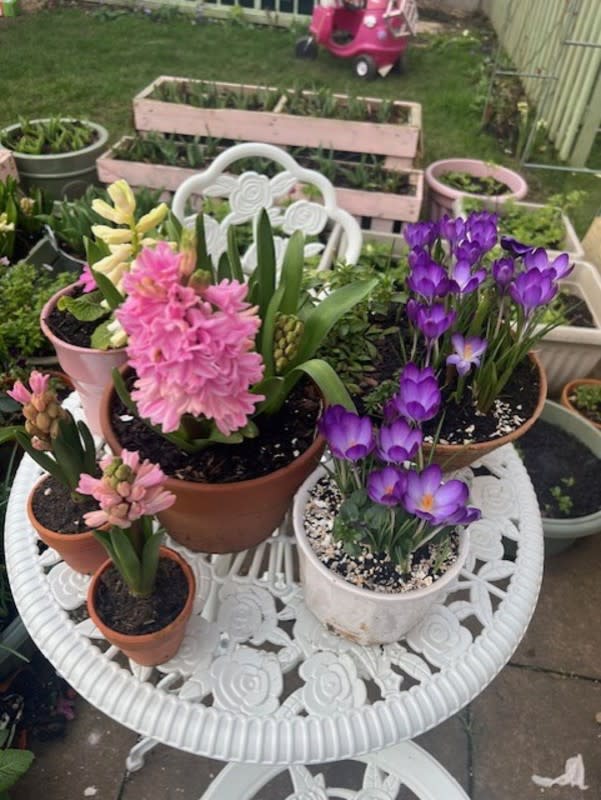
Gina Mellard - Gina's Flower Garden
8. Crocus
"Crocuses are among the first flowers to poke their heads out in spring. It typically signifies that spring is coming and is often a welcome bloom by so many! It is a low-growing flower that comes in purple, white and yellow colors," Walker explains.
Plant bulbs in the fall at a depth of 3-4 inches, and they prefer full sun to partial shade and well-drained soil. After flowering, Thurmon advises allowing foliage to die back naturally. Crocus blossoms are also magnets for winter bees, who are drawn to the rich, pollen inside each flower.
Pros: "The bees love them, and I saw the first bee of the season on my crocus. They look cute in little containers too," Mellard shares.
Cons: According to Mellard, if the weather is very wet, they don’t look the best and they only open if there’s a little sun.
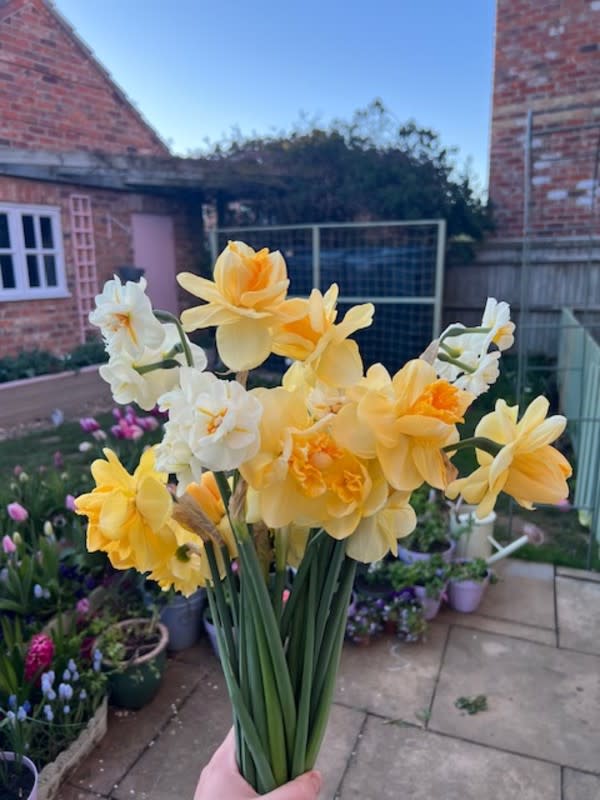
Gina Mellard - Gina's Flower Garden on Instagram
9. Daffodil
Daffodils are often one of the first flowers in bloom in many gardens during the spring.
"Daffodils light the garden with their beautiful, fragrant aroma and bright yellows, pinks, white and orange flowers, ranging from early season to late season bloomers. Daffodil bulbs are generally planted in the fall, perennialize well in many locations and will multiply over the years in the garden," Jamison tells Parade.
"There's so many varieties to choose from, all with different heights and shades," adds Mellard. Daffodils grow from bulbs, so it is best to plant those in the fall in order to enjoy them during the spring bloom.
Pros: They come back year after year and bring joy with their cheerful colors after winter, Mellard shares. Lovely cut flowers; perfect in containers.
Cons: According to Mellard, daffodils are prone to overcrowding. You may have to dig up and space out a little after a few years.
10. Diascia
As an annual, diascia (or twinspur) adds a tasteful splash of color to any of the baskets, borders or flowerbeds you have in your backyard. Adorn your quiet spot with pinks, coral, white and even orange diascia.
Pros: Diascia are not prone to bugs or disease, they are easy to maintain and do not require deadheading.
Cons: For best results with diascia, fertilization may be required.
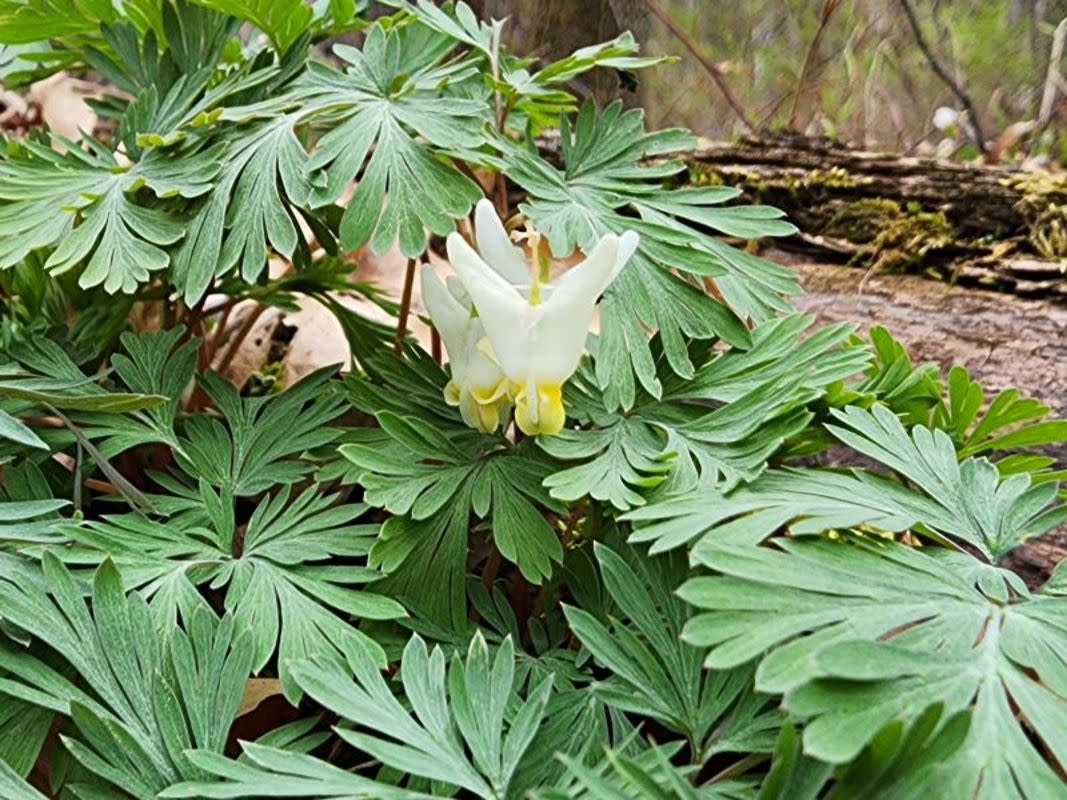
Wendee Wendt - My own backyard
11. Dutchman’s Breeches
During early spring, for about two weeks, you can adorn your grounds with some Dutchman's Breeches. Their name is fitting, as little white flowers with tiny yellow centers dangle off of stems and (in the shape of a "V") look just like old Dutch breeches. They grow from corms, which are similar to bulbs, so you will have the best luck to plant them in the fall.
Pros: The flowers of the Dutchman are an early source of nectar for emerging bees.
Cons: Only to be enjoyed in the ground; they will wilt almost immediately upon picking.

Gina Mallard - Gina's Flower Garden on Instagram
12. Forget-Me-Nots
Mellard thinks forget-me-nots are, "so beautiful; tiny blue flowers that make you smile. They also come in pink or white. Lovely companion plants as part of a display or in their own container. Pretty in bouquets with roses."
Pros: Mellard shares these are very easy to grow from seed and you can easily dig them up and move them to where you want them. Lovely with foxgloves and alliums.
Cons: Some people don't like the amount of self-seeding, and they do spread, Mellard warns.
13. Forsythia
Go bold; go yellow! The forsythia springs into bloom before its leaves even come in, making your backyard instantly bright and cheery. Planting in the ground as a shrub is pretty popular, but you can also make them work in containers too.
Pros: Easy to grow and can even be planted in colder weather as long as the ground isn't frozen, or frost isn't imminent.
Cons: The bush itself is a little "blah" after it is done flowering, as it then lends itself as a green background for the rest of the summer. Also, you can ruin your bush with improper pruning. Make sure to do your homework before snipping.
Related: What Is Your State Flower? Your Guide to All 50 Blooms from Alabama to Wyoming
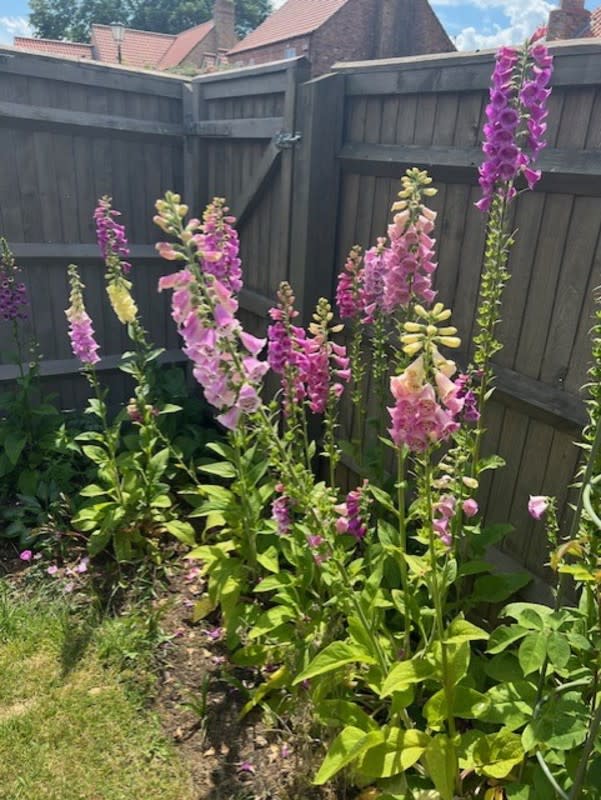
Gina Mellard - Gina's Flower Garden on Instagram
14. Foxglove
Foxglove are described by Mellard as "enchanting—like a fairytale flower." They have many colors to choose from and have a plethora of bell-shaped blossoms on each stem.
Pros: Tall with a beautiful structure that looks perfect in a cottage garden border, they don’t mind being moved around, Mellard shares.
Cons: High toxicity if eaten, so something to be mindful of, according to Mellard. Some are biennial, so they take a long time to flower from sowing. You need to let them self-seed or sow more each year.
15. Freesia
Freesias are beautifully scented flowers that have funnel-shaped petals lining the stem. It is a popular spring garden flower and comes in a rainbow of colors. This spring bloom is especially sought after for wedding flowers because the scent adds romance to a bridal bouquet, as Walker explains.
With its bright blooms (so many colors to choose from!) and citrusy perfume, freesia is a great choice to keep the spring blooms coming. They don't show quite as early as some of the other choices on the list, often waiting until mid-spring to start showing off. Freesias are upward-facing, tubular flowers that blossom from only one end of the stem.
Pros: They love hot, dry planting sites and do well in containers or along patios.
Cons: It's not the prettiest thing in the garden after it is done blossoming. Also, it is crucial to leave the leaves to wilt and shrivel completely before tending to them. This is when the plant is growing new bulblets.
16. Glory of the Snow
Another hardy flower, glory of the snow has a fitting name. It can be found with flowers on it so early in spring that snow may still be coating the ground. They have long, grass-like leaves and are embellished with small, six-petal flowers, often in shades of blue, white or pink.
Pros: They are so easy to grow and can be planted anywhere where you have at least partial sun, including in containers.
Cons: Once the plant dies, you will need to leave the leaves until they are completely brown and dried out. (This will continue to feed the bulbs some extra nutrients. However, it won't be the nicest to look at until you can pull them out.)
17. Hellebore
Hellebores are a group of low-maintenance perennial flowering plants prized for their ability to thrive in shady garden spots. Thurmon says they bloom in early spring and come in an array of white, pink, purple, green and even near-black. She also recommends a moist, well-draining soil with plenty of organic matter.
"For floral arrangements, cut hellebore flowers when the seed pod has formed and the flower can last a few weeks in a vase!" Jamison suggests.
Hellebores are slow growers and occasionally take two seasons before flowering.
Pros: They're low maintenance. And with winter and early spring flowering, they are often one of the only flowers in the garden, Mellard says.
Cons: Mellard warns that the flowers are pretty but often point downwards.
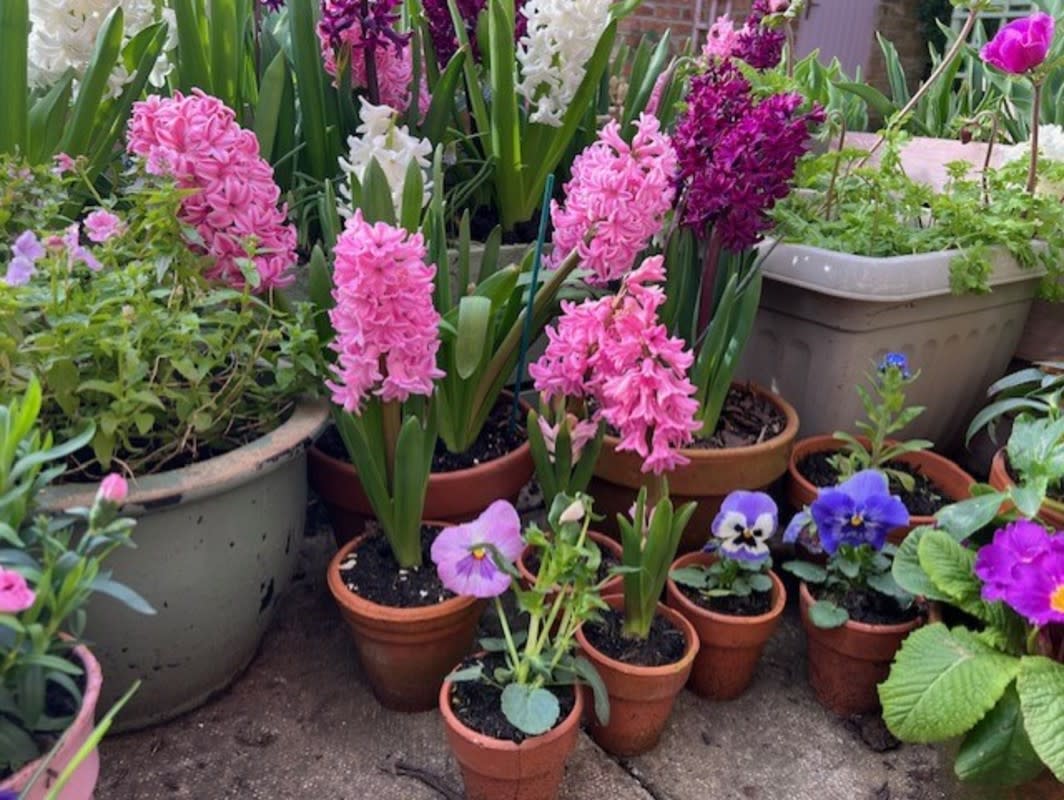
Gina's Flower Garden on Instagram
18. Hyacinth
"Hyacinths are fragrant flowers that come in a range of colors and are excellent for borders or containers," Thurmon says, adding that it's recommended to plant bulbs in the fall in well-drained soil.
Provide full sun to partial shade and keep soil evenly moist during the growing season. Once flowers fade, allow foliage to wither. They will come back year after year and are also good for forced blooming indoors.
"The scent is amazing, my favorite of any spring flower," Mellard says.
You often see hyacinths in stores around Easter time, making wonderful and renewable gifts.
Pros: "Easy bulbs to plant and grow," Mellard says. "Will come back."
Cons: The bulbs are a bit more expensive (worth it), and the flowers are not at their best for long, Mellard explains.
19. Iris
Spring backyard gardens and iris flowers often go hand-in-hand. Jamison calls them "the gift that keeps on giving" throughout the years, due to how vigorously the iris multiplies yearly. It is good to divide the iris every three years to keep the plant blooming strong.
"Many iris are fragrant, and my favorite is one that smells like grapes because it reminds me of my Mom who gifted it to me years ago!" Jamison shares.
This is one of the most diverse groups of plants, with over 200 varieties. With that many to choose from, you are bound to find a perfect iris for your garden. They have upright flower petals that are surrounded by drooping ones called "the falls" and come in almost every color.
Pros: You can plant Iris in pots too! You just need to water and fertilize more frequently. Remember, if you are in a colder climate region, you will need to dig up the rhizomes and bring them inside during winter.
Cons: Iris tend to cluster up and need to be dug up and spread out to keep them healthy. They also need care when planting as to not put them too deep into the soil. The tops of the rhizomes need to be exposed.
20. Lenten Rose
A perennial in the hellebore family, this spring hybrid belongs in the buttercup family. With rose-like flowers, this plant thrives in the shade and is pretty easy to grow.
Pros: As long as you keep them out of the sun and watered regularly, the lenten rose has one of the easiest upkeeps.
Cons: The lenten rose is toxic to both pets and humans.
Related: Create Your Own Butterfly Paradise With These 35 Plants and Flowers That Attract Butterflies
21. Lilac
Lilacs are clustered, scent-filled spring bloomers that bring joy to anyone who passes them by. They are best known for their clusters of small, tubular flowers that appear in spring, typically in shades of purple, lavender, pink, white or blue, depending on the variety. Walker recommends planting lilac bushes in an area that receives full sun, but they do not thrive in hot climates.
Pros: Lilacs thrive regardless of planting them as a lone shrub, in mass groups or when used as a hedge privacy fence. Bees absolutely love lilacs too.
Cons: Lilacs need to be pruned, and must be done in the spring, after the flowers are done blooming.
22. Lily of the Valley
Lily of the Valley are highly toxic if ingested, so it's worth heeding caution with this flower. However, it is a beautiful spring bloom. Known for its sweet fragrance and dainty, bell-shaped white flowers, this perennial is a symbol of purity.
"They bloom for about 3 weeks before reddish berries appear. Plant in a shaded area where they have room to spread. Keep away from other perennials, as they might take over," Thurmon suggests.
Pros: Being a shade-loving plant, they can be used to fill in space below hedges and trees.
Cons: Not only can lily of the valley become invasive if not kept in check, but they are toxic to pets and people.
23. Lupins
Bees are a big fan of lupins. Also, Mellard tells Parade that lupins "are unique and look lovely paired with alliums."
Lupins like sun, and the taller flower stems may need to be staked in order to keep them upright.
Pros: Lupins can structure to a border, and they're easy to grow from seed, Mellard says.
Cons: Some may view them as invasive, Mellard warns, adding that they are prone to aphids.
24. Magnolia
A large genus of flowering shrubs or trees, the magnolia is magnificent, even if for just a short time in the earliest days of spring. Their size can be from a 15 shrub to a massive tree, so planning space for a magnolia ahead of time is vital.
The Saucer Magnolia is also known as Japanese Magnolia, and it’s one of the most strikingly beautiful blooming trees in spring.
"They grow best in full to partial sun in well-drained, slightly acidic soil. They are the perfect accent tree around a home. The flowers are very fragrant and are edible too!" Thurmon explains.
Pros: Magnolias do not mind drier conditions and need very little pruning, except when it has a dead or broken branch.
Cons: Flowers drop early in heavy rain or wind, which spring is prone to providing.
25. Pansy
Pansies are annuals that can add a lot of color to your garden and home in the spring. They are perfect for pots and thrive in cooler temperatures. These can be planted out in late winter and bloom until summer. Thurmon shares that it's best to remove spent flowers regularly to promote continuous blooming and prevent seed formation.
Walker adds, "Pansies are cheery little blooms that look as if they have a little upturned face that stares back at you! The blooms of the pansy are edible and can be added to pastries, salads and beverages."
Pros: According to Mellard, pansies are lovely bedding plants that are great in mixed containers or topped on a "bulb lasagna." (Bulb lasagna is a cute way of saying that you layered your bulbs in a container to maximize space and extend the blooming period of that container.)
Cons: They can look untidy when they start to go past their best, Mellard warns.
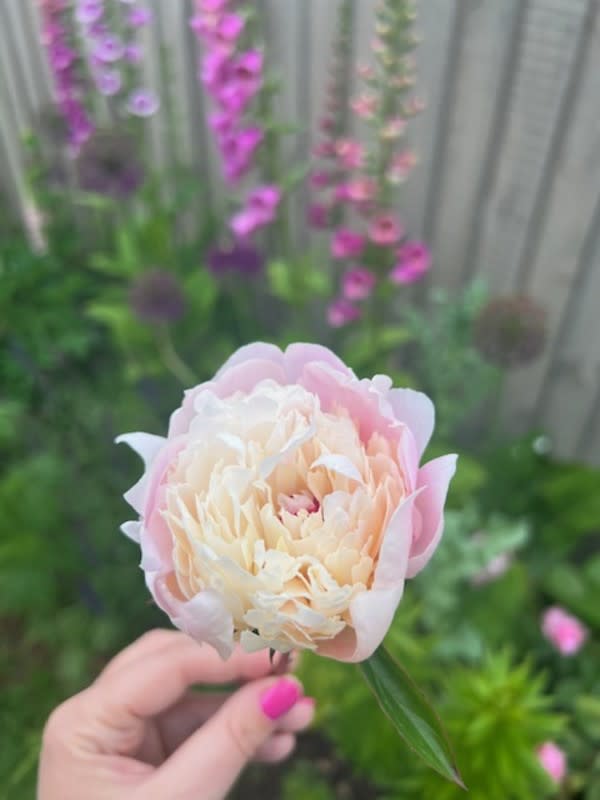
Gina Mellard - Gina's Flower Garden on Instagram
26. Peony
Peonies are often thought of as the "Queen of Spring" when it comes to their show-stopping flowers. They are known for their lush foliage, large showy blooms and captivating fragrance. Peonies make an excellent focal flower in any garden or cut flower arrangement. "There’s nothing quite like a peony flower. They are beautiful in bouquets," Mellard notes.
They also do well when planted in a mixed border with roses and irises. Make sure to provide support for heavy flower heads to prevent them from drooping. Keep them watered and deadhead spent blooms.
Pros: According to Mellard, they are cheap to plant as bare roots, and once established, will last many years. So, they are an investment.
Cons: Peonies may take a few years to flower if it is a new plant, Mellard warns. They have a fairly short flowering season compared to roses.
Related: 5 Gorgeous Flowering Shrubs to Plant This Fall That Will Thrive in the Springtime
27. Phlox
When planting Phlox, pay attention to the variety. There are tall, wild and creeping variations of phlox, and some like sun, some do not. Make sure the ones you choose to plant make sense with your area.
According to Thurmon, creeping phlox form a colorful carpet of flowers in early spring, and do best in well-drained soil with full sun. She suggests pruning lightly after flowering to maintain shape and promote new growth. Get ready for them to come back reliably every season and attract pollinators with their fragrant blooms!
Pros: These plants will last, beginning in spring all the way up to the first killing frost. Once frost hits, you only need to trim them back to about two inches for them to thrive the next year.
Cons: Phlox are prone to powdery mildew when not given enough room to breathe. It does not kill the plant, but is unsightly.
28. Primrose
Fans of The Hunger Games, unite! Primrose flowers come in a rainbow of vibrant colors and often offer the pop of color that is needed after a long, cold winter. Primrose performs best in cooler climates, but can be grown successfully during the winter in warmer climates. They prefer partial sun over deep shade.
Pros: As long as the conditions are right for the type you are planting, the primrose is hardy and does excellent in almost any container, border or flower bed. They can also naturalize lawns beautifully.
Cons: They do not like really wet soil and will rot quickly.
29. Snapdragon
"Snapdragons are a cut-and-come-again flower through the late spring and into early summer that is a 'spike flower.' The stem is densely packed with blooms that begin to bloom from the bottom up," Jamison explains.
"Snapdragons benefit from the art of 'pinching' when the plant is young because this will encourage more stems to form on the plant, thus giving even more blooms to enjoy in the garden or use in cut flower arrangements," she adds.
With a little snip of the ends, the blossoms will grow in fuller, and it will help them from getting too top-heavy.
Pros: Snapdragons can be grown in containers and moved out in the early spring, even if it's still cold.
Cons: Some older varieties get tall and top-heavy; they will need to be staked. Some snapdragons are prone to rust and powdery mildew.
30. Snow Drops
Snow Drops are one of the first to bloom in spring and are a sign that warmer weather is just around the corner. They are very easy to care for and perennials that will come back year after year. Thurmon advises planting them in moist, well-drained soil in partial shade to full shade. After flowering, allow the foliage to die back naturally to replenish the bulbs for the following year.
If you plant these dainty white flowers under your trees in your backyard, they will eventually colonize. No pruning or deadheading is necessary. Just plant and enjoy.
Pros: Pest and disease-resistant, and they can be grown just about anywhere.
Cons: Toxic to cats, dogs and humans.
31. Sweet Pea
Want something classy and colorful for your backyard garden? Then say "yes" to planting some sweet peas.
Sweet peas are a climbing type of flower that produces multiple trailing vines with clusters of flowers at the end. Native to the Mediterranean, sweet peas have been cultivated for centuries for their value and scent. They come in a wide range of colors, including shades of pink, purple, red, white and blue, often with bi-colored or tri-colored patterns.
"One of the most distinctive features of sweet peas is how fragrant the flowers are, which makes them a must to grow in a sunny spot in your spring garden," Jamison says.
Pros: They love the sun and need just a little pruning. Pruning guarantees more flowers, so it's a win-win.
Cons: They are toxic to people and their pets. They will climb, so you will need to plant properly to avoid them climbing and ruining your other plants in the garden.
32. Trillium
Growing from bulb-like rhizomes, trillium can often be spotted in the woodlands. But they also make fabulous additions to your backyard. They have three dark green leaves and showy, snow-white flowers.
Pros: They thrive in shaded beds or woodland gardens.
Cons: Wild trilliums do not transplant well (and some are even endangered and, therefore, protected). You should avoid transplanting and purchase from the store instead.
Related: What Does the Lotus Flower Symbolize, Exactly? Experts Reveal Its Significance
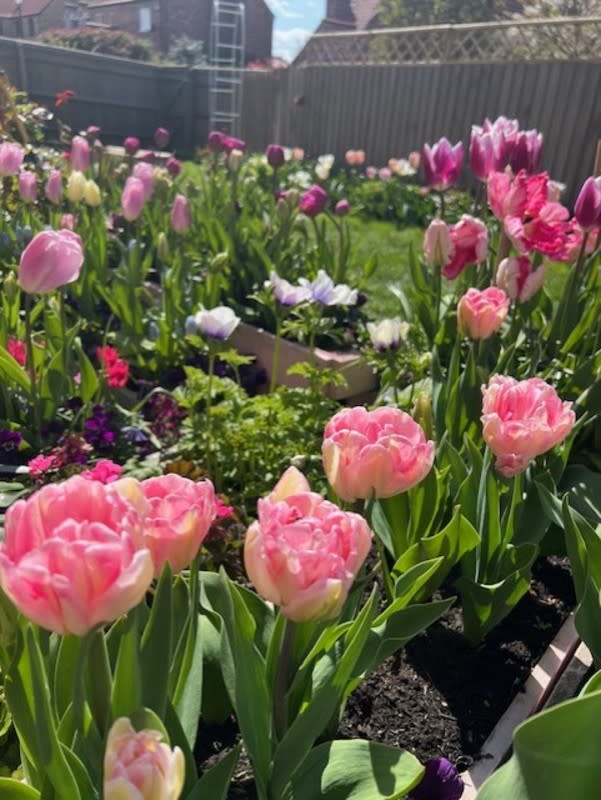
Gina Mellard - Gina's Flower Garden on Instagram
33. Tulips
Tulips are certainly one of the most popular spring flowers. With a kaleidoscope of colors, tulips offer endless possibilities for adding charm and elegance to your outdoor space.
Described by Mellard as "one of the most beautiful spring flowers," she explains that some of the variations are called "lily style, parrots, traditional [and] fringed."
Thurmon recommends planting tulip bulbs in the fall to ensure a spectacular display of vibrant blooms come springtime. To optimize their growth and longevity, provide tulips with full sun exposure and well-drained soil. Additionally, regular deadheading of spent flowers maintains the tidiness of the garden and encourages robust bulb development, ensuring tulips for years to come.
Pros: According to Mellard, tulips are easy to plant and they're good in containers. Early and late flowering varieties allow good succession.
Cons: They may not come back as well after the first year, and squirrels sometimes eat the bulbs, Mellard explains.
34. Violets
Cute little flowers that pack a punch in springtime, violets can be planted or found wild. The flowers are edible, and used often to decorate cakes or garnish salads. They come in a multitude of colors ranging from pastel to bright hues, along with multifaceted petals.
Pros: They are cold tolerant, popping up in early spring, and will reseed for years to come.
Cons: Violets are prone to root rot if left in standing water. Make sure to not overwater them, and that they are planted in soil that drains well.
35. Wallflowers
Considered a shrubbery or groundcover type plant, these pretty little flowers look fantastic next to spring bulb flowers. They do best when planted in sunny areas, and acclimate best in warmer climates.
Pros: Wallflowers are considered drought tolerant and do well in full sun situations.
Cons: These flowers do not like to be in wet, boggy soil. They need well-draining dirt, comprised of a mixture of sand and rocks added to it.
36. Winter Aconite
The winter aconite can often be found blooming before crocus which, at times, put their buttercup flowers sprouting while snow is still found on the ground.
Pros: Great for adding color to gardens and borders, especially where you want to add a bit of spring early color, like along your backyard sidewalks.
Cons: Once their two-week bloom is done, their greens go dormant. This leaves it vulnerable to being forgotten about and dug up by accident. Make sure to mark where your plants are to avoid this from happening. They are also toxic to people and pets.
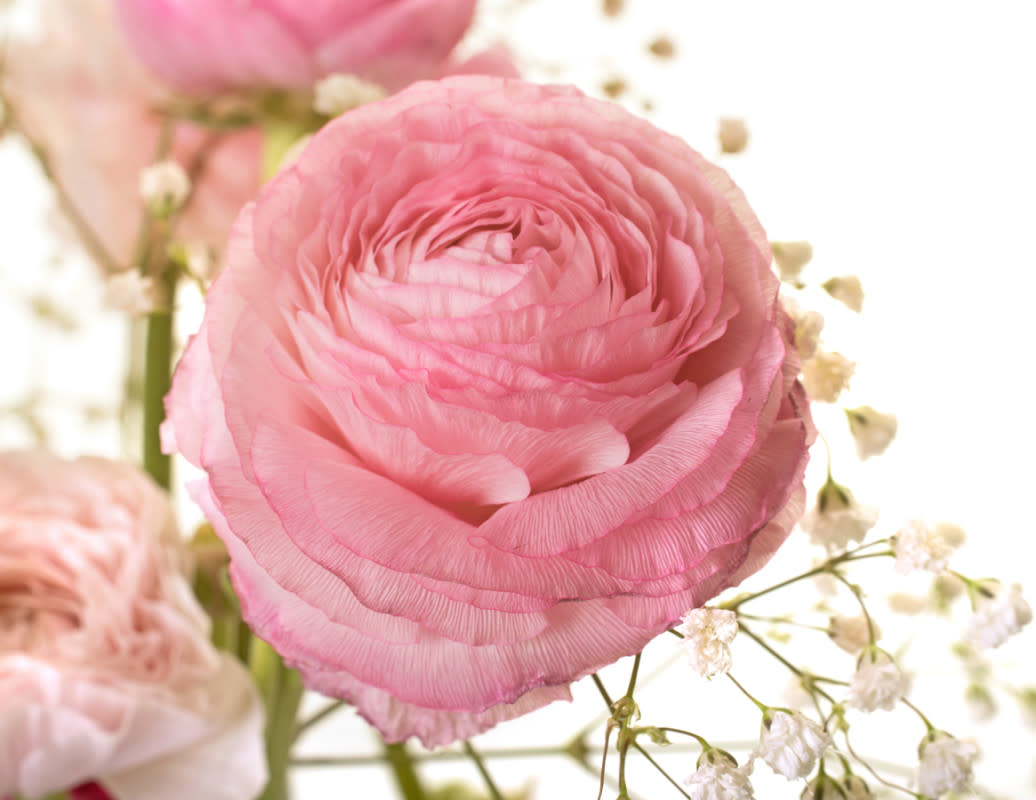
iStock
37. Ranunculuses
As Walker mentioned above, ranunculuses are a spring flower that have gained popularity in recent years. They are multi-petaled flowers that are popular in bouquets and arrangements, but look especially beautiful in the landscape. Ranunculus are sometimes confused for roses and are referred to as the "rose of the spring."
Pros: The bulbs can be left in the ground to grow again the following year.
Cons: They prefer cooler temperatures in order to thrive.
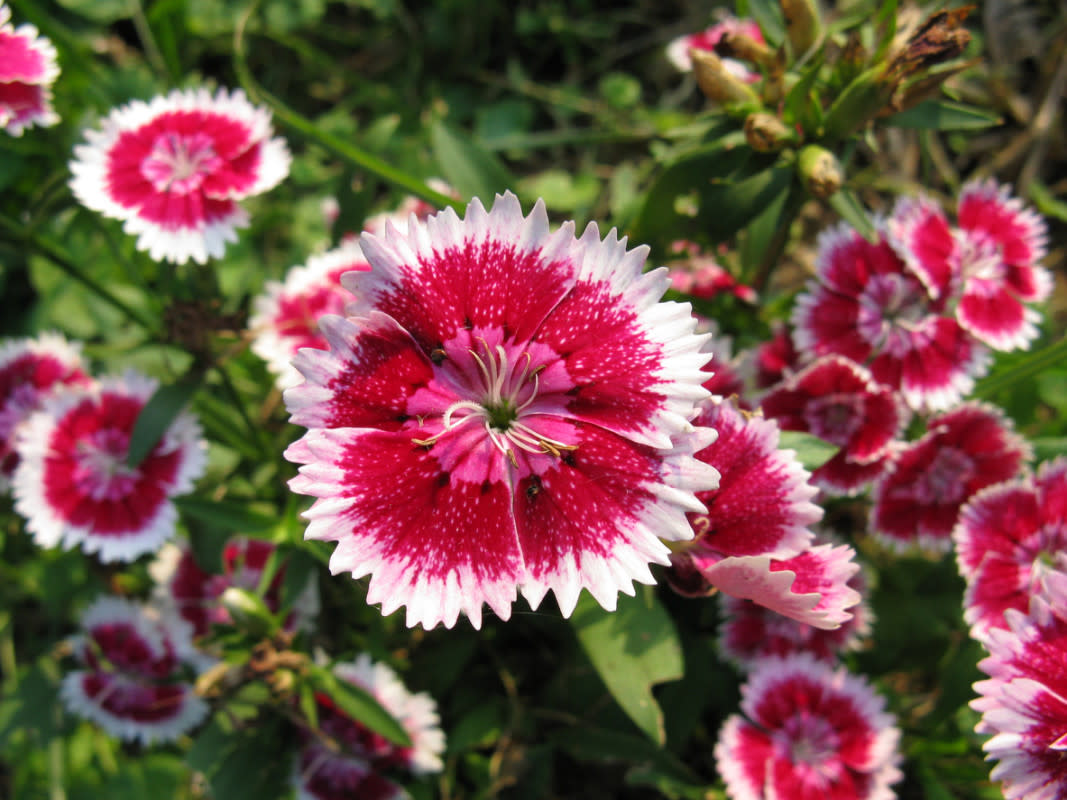
iStock
38. Sweet Williams
Sweet William is a beautiful circular-shaped, pom pom-pom-like flower that blooms mid-spring.
These spring flowers are widely cultivated for their clusters of small flowers that bloom in hues of pink, red, white and purple, often with contrasting markings or patterns. The flowers typically have serrated edges, giving them a delicate, fringed appearance.
Pros: Jamison says they are an excellent cut flower because they can last a couple of weeks in a vase.
Cons: Poisons both dogs and cats.
Related: It’s Actually Surprisingly Easy Being Green! 55+ Plants You Can Grow in a Hydroponic Garden
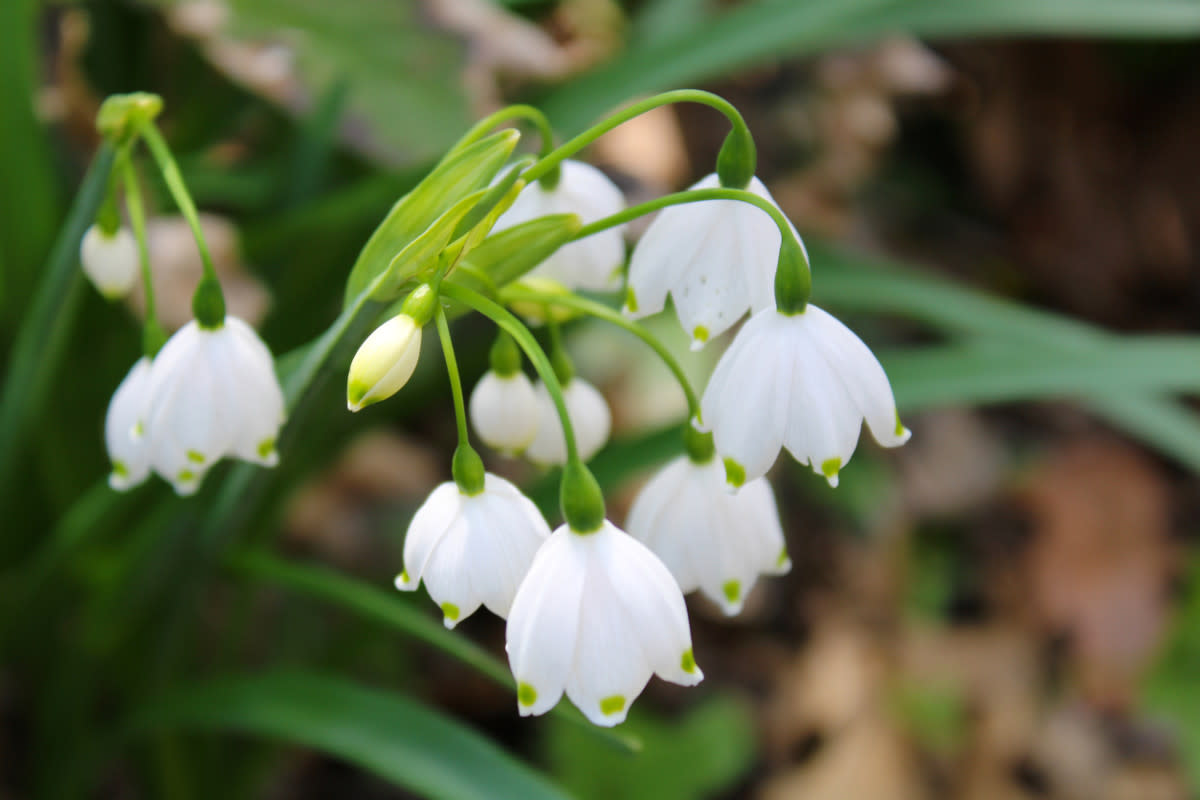
iStock
39. Summer Snowflakes
"Don't be fooled by its name, this delightful flower is a spring bloomer! These are magical flower that have a a long stem with white, drooping blooms along it that resemble a fairy lantern—if one has the imagination for it," Walker tells Parade.
Summer snowflakes are easy to grow and prefer moist, well-drained soil in partial shade to full sun. They are known for their resilience and ability to naturalize.
Pros: Despite their delicate appearance, summer snowflakes are deer-resistant and low-maintenance.
Cons: They can attract snails and slugs.
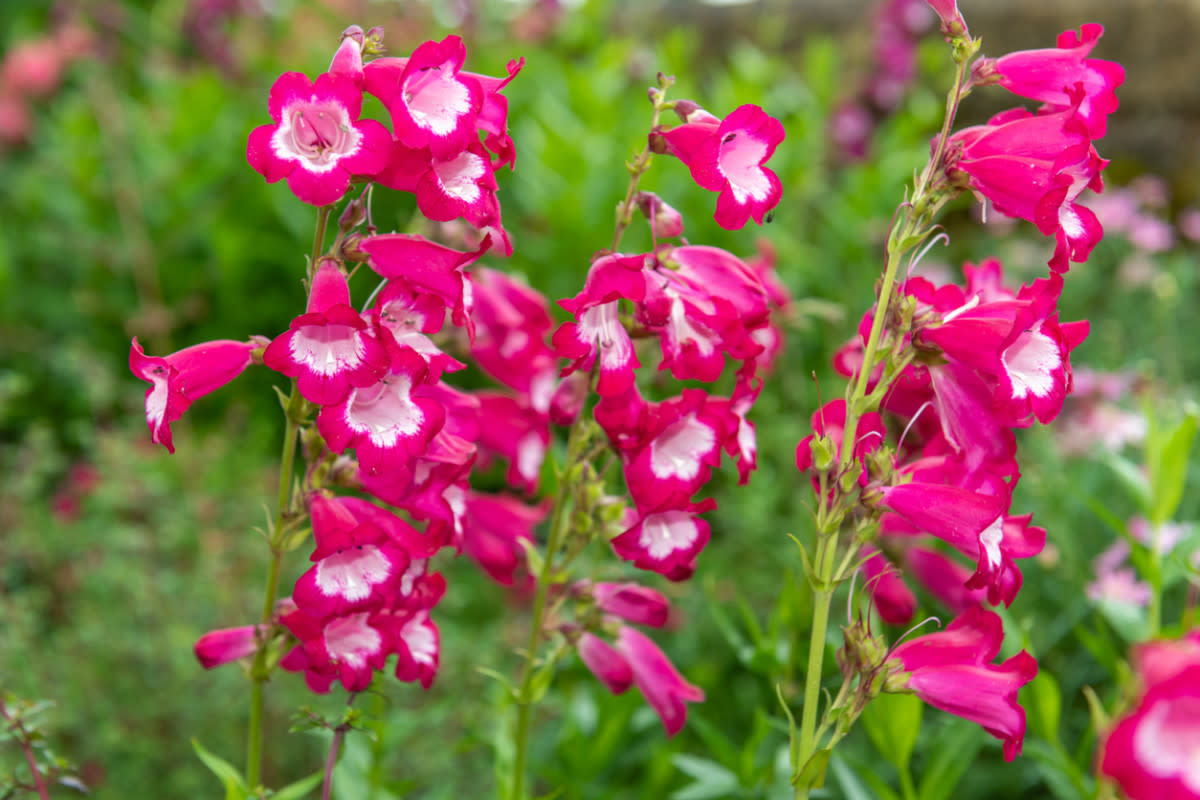
iStock
40. Penstemon
Penstemon is an often overlooked plant on many spring favorite flower lists, but Jamison has raved to Parade all about these beautiful spring flowers. They are a native flower to North America and one of the most versatile plants, for both the garden and cut flower arrangements. In mid-spring, they begins to bloom and the pollinators love to mingle in the florets!
"If the flowers are not cut for arrangements, the flower heads eventually turn into brown pods that are not only beautiful to look at in the garden all summer, fall and winter, but are excellent to use in floral arrangements, as well," Jamison explains.
Pros: They're attractive to hummingbirds.
Cons: They don't like to be crowded by other plants.
Tips for Spring Flower Maintenance
Planting your spring flowers is one thing. Maintaining your beautiful spring flowers for years to come, however, is a whole other battle! Walker provides a list of tips for maintaining your spring flowers to their best health.
Flowers typically do best in loose and well-draining soil with plenty of organic material.
Bulbs should be planted in September through October (or October through December in warmer climates) and left to bloom in the spring.
Avoid planting bulbs in areas with poor drainage or where water collects as this could rot your bulb.
Before planting anything in the spring, clean up your garden beds. Pull or trim any dead plants and branches, remove rocks and weeds and add fresh compost.
Flowers do best when soil temperatures reach 65-75 degrees Fahrenheit. Soil temperature differs from air temperature and should be measured to ensure accuracy.
Jumpstart planting your spring flowers by planting them in containers, since containers will warm up faster than the plants in the ground and they can be moved to protect from a late frost.
The best way to know if you should start planting is by consulting the USDA Plant Hardiness Zone Map and entering your zip code to determine what zone you are in.
Seed packets contain helpful information and will tell you when to plant based on your frost dates.
Start planning for your spring garden in the fall. If you wait until spring, you will have already missed the window for planting bulbs.
By planning your garden two seasons ahead, you will be prepared when the time for planting arrives and you will know what to plant and where to plant it.
Next up: Why Are Poppies Used for Memorial Day? Here’s What They Mean
Expert Sources
Connect with the experts:
Stephanie Walker
Annette Thurmon
Order her book, Simple Country Living
Listen to the Happy Farmily Podcast


























